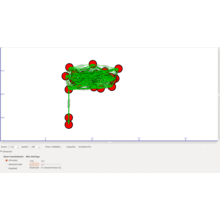Tag Archive: '2015 ns3 projects'
In a centralized radio access network (C-RAN) scenario the joint coordination of radio (e.g., remote radio units, baseband units) and transport (e.g., optical cross connects) resources can be achieved viasoftware defined networking (SDN) control plane, where a global orchestrator harmonizes the use of resources across all network segments. The more accurate the information about each domain (i.e., the abstraction of wireless and […]
Finding an effective and simple unified control plane (UCP) for IP/dense wavelength division multiplexing multilayer optical networks is very important for network providers. Generalized multi-protocol label switching (GMPLS) has been in development for decades to control optical transportnetworks. However, it is extremely difficult to deploy in real operational products, as there is still much non-GMPLS-capable equipment. On the other […]
An IP address is used as a host identifier and a locator to bind hosts and applications to their location in existing Internet. Several protocols are proposed to eliminate this binding. Most of these protocols use IPv6-based host identifiers to maintain compatibility with existing Internet, but these identifiers cannot be handled by standard IPv6 routers […]
This paper presents the challenges and purpose of building the Traffic Engineering Database (TED) to facilitate Software Defined control of an Elastic Optical Network (EON). It explains how a standardized protocol and data model can facilitate this and describes a YANG model that has been developed to represent the TED including the representation of nodes, transponders, links, and available media […]
Network planning is facing new and critical challenges due to ad hoc deployment, unbalanced and drastically varying traffic demands, as well as limited backhaul and hardware resources in emerging small cell architectures. We discuss the application of graph theory to address the challenges. A clique-based software-defined online network management approach is proposed that captures traffic imbalance and fluctuation of small […]
In this study, we investigate the task offloading issue in mobile social networks. Although the ‘d-choice’ paradigm in ‘ball and bin’ theory [1] had shown the power of random choice in load balancing with random walk model, its performance could be fairly poor when real trace data sets are concerned. According to our preliminary evaluation results with […]
In this paper we propose resource optimization for subscription based media content crowdsourcing. In this form of crowdsourcing, interested entities (we refer to them as Campaigners) announce their `interests’ expressing what media content (such as pictures, audio, and videos) they want to receive from participant users whereas mobile users subscribe to those interests as an […]
Driving is an integral part of our everyday lives, and the average driving time of people globally is increasing to 84 minutes everyday, which is a time when people are uniquely vulnerable. A number of research works have identified that mobile crowd sensing in vehicular social networks (VSNs) can be effectively used for many purposes and bring huge […]
There’s growing interest in developing applications for the Internet of Things. Such applications’ main objective is to integrate technology into people’s everyday lives, to be of service to them en masse. The form in which this integration is implemented, however, still leaves much room for improvement. Usually, the user must set parameters within the application. […]
A lot of personal daily contexts and activities may be inferred by analyzing acoustic signals in vicinity. Conversations play an important role in one’s social communications. In this work, we consider the inference of conversation partners via acoustic sensing conducted by a group of smartphones in vicinity. By considering the continuity and overlap of speeches, we propose […]

 Click Here to watch our latest output video using NS3 simulator
Click Here to watch our latest output video using NS3 simulator  Click Here to watch our latest projects screenshots using NS3 simulator
Click Here to watch our latest projects screenshots using NS3 simulator